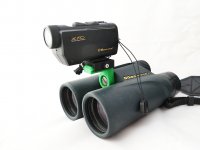Hi everyone,
I just created a 3D-printed adapter to mount action cameras to bincoulars:

This relies on the binoculars having a 1/4" thread in the hinge, and the action camera being compatible with a NATO/Picatinny rail.
The adapter is customizable and can be downloaded here:
https://www.thingiverse.com/thing:3027974
For practical application, my old action camera is problably a bad choice as it has a wide-angle lens when obviously, in combination with binoculars a tele lens would be preferrable.
If anyone has a recommendation for an action cam that has a useful telephoto range, your recommendation would be highly welcome! I have no idea of what the current generation of action cams might be capable of ...
Regards,
Henning
I just created a 3D-printed adapter to mount action cameras to bincoulars:

This relies on the binoculars having a 1/4" thread in the hinge, and the action camera being compatible with a NATO/Picatinny rail.
The adapter is customizable and can be downloaded here:
https://www.thingiverse.com/thing:3027974
For practical application, my old action camera is problably a bad choice as it has a wide-angle lens when obviously, in combination with binoculars a tele lens would be preferrable.
If anyone has a recommendation for an action cam that has a useful telephoto range, your recommendation would be highly welcome! I have no idea of what the current generation of action cams might be capable of ...
Regards,
Henning





